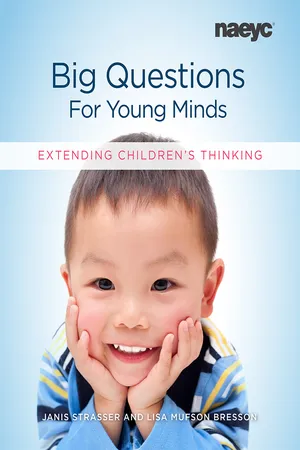
eBook - ePub
Big Questions for Young Minds
Extending Children's Thinking
- English
- ePUB (mobile friendly)
- Available on iOS & Android
eBook - ePub
About this book
Questions are powerful tools, especially in the classroom.
Asking rich, thoughtful questions can spark young children’s natural curiosity and illuminate a whole new world of possibility and insight. But what are “big” questions, and how do they encourage children to think deeply? With this intentional approach—rooted in Bloom’s Taxonomy—teachers working with children ages 3 through 6 will discover how to meet children at their individual developmental levels and stretch their thinking. Featuring contributions from respected names in the field, this book:
- Offers a foundation for using high-level questions in preschool and kindergarten interest areas
- Provides tips for getting started and examples of questions at each of the six levels of questioning
- Explores the use of high-level questions during daily classroom routines and in a variety of contexts
- Recommends picture books that support the use of high-level questions
- Includes an extensive resource section for teachers and families
Frequently asked questions
Yes, you can cancel anytime from the Subscription tab in your account settings on the Perlego website. Your subscription will stay active until the end of your current billing period. Learn how to cancel your subscription.
No, books cannot be downloaded as external files, such as PDFs, for use outside of Perlego. However, you can download books within the Perlego app for offline reading on mobile or tablet. Learn more here.
Perlego offers two plans: Essential and Complete
- Essential is ideal for learners and professionals who enjoy exploring a wide range of subjects. Access the Essential Library with 800,000+ trusted titles and best-sellers across business, personal growth, and the humanities. Includes unlimited reading time and Standard Read Aloud voice.
- Complete: Perfect for advanced learners and researchers needing full, unrestricted access. Unlock 1.4M+ books across hundreds of subjects, including academic and specialized titles. The Complete Plan also includes advanced features like Premium Read Aloud and Research Assistant.
We are an online textbook subscription service, where you can get access to an entire online library for less than the price of a single book per month. With over 1 million books across 1000+ topics, we’ve got you covered! Learn more here.
Look out for the read-aloud symbol on your next book to see if you can listen to it. The read-aloud tool reads text aloud for you, highlighting the text as it is being read. You can pause it, speed it up and slow it down. Learn more here.
Yes! You can use the Perlego app on both iOS or Android devices to read anytime, anywhere — even offline. Perfect for commutes or when you’re on the go.
Please note we cannot support devices running on iOS 13 and Android 7 or earlier. Learn more about using the app.
Please note we cannot support devices running on iOS 13 and Android 7 or earlier. Learn more about using the app.
Yes, you can access Big Questions for Young Minds by Janis Strasser,Lisa Mufson Bresson in PDF and/or ePUB format, as well as other popular books in Education & Early Childhood Education. We have over one million books available in our catalogue for you to explore.
Information
Year
2019Print ISBN
9781938113307Using Questions in Classroom Interest Areas

1
Dramatic Play Area
The children in Ms. Liggieri’s mixed-age preschool classroom are playing in the interest areas of their choice. In the dramatic play area, 5-year-old Josie dons a red satin kimono embroidered with birds and ties a long piece of blue-sequined fabric around her head. The finishing touch is a striped necktie from the costume basket, which she puts on over the kimono. She then stands in front of a large mixing bowl, stirring intently as she dumps in every piece of pretend food, a collection of smooth river rocks from the science area, several Unifix cubes from the math area, and a handful of pom-poms from the classroom makerspace.
Giuseppe sits at the table next to the bowl with a notepad in front of him, scrawling numbers and letter-like shapes across the page in blue crayon. “You gotta keep mixing!” he excitedly tells Josie.
Ms. Liggieri notices the mixture of toys taken from all over the room in Josie’s bowl. Her first instinct is to ask the children not to jumble so many toys from different areas together, but before speaking, she sits by them and quietly observes their play. She notices that each time Josie adds a new toy to the bowl, Giuseppe makes a mark on the notepad. She quickly realizes that the two have created a highly complex play scenario that involves not only role playing and creative costumes but math and literacy as well.
“What are you making, Josie?” asks Ms. Liggieri.
“It’s soup!” Josie exclaims. “I’m mixing and Giuseppe is doing the recipe. He’s my helper cook, and all our friends are coming over for the party.” She motions to the crib where they have lined up all of the dolls, an aspect of the play that Ms. Liggieri hadn’t noticed.
Instead of asking a simple question like how many people are coming to the party or what color Josie’s kimono is, the teacher decides to follow Josie’s lead and asks how Josie got the idea to make a recipe.
Ms. Liggieri then asks if she can help them prepare for their party. Giuseppe tells her to take care of the babies. Ms. Liggieri engages in play with the pair for 15 minutes, mindful not to disrupt or direct their play, and asks them several open-ended questions about the math and literacy aspects they have incorporated into their party preparations. As she moves toward another group of students, she makes a note to go back to the dramatic play area during cleanup time with the containers for the materials Josie has used. She plans to engage the children in a sorting activity using the labels on the containers as they deconstruct the toy soup they have made for the party.

The question was not how would I enter [the children’s play] but, rather, what were the effects of my intervention? When did my words lead the children to think and say more about their problems and possibilities, and when did my words circumvent the issue and silence the actors? When did my answers close the subject?
—Vivian Paley, “On Listening to What the Children Say,” Harvard Educational Review
The world of pretend play is limitless. Young children can become so completely immersed in fantasy scenarios that everything around them falls away as they explore the inner world of their imaginations. The dramatic play area provides a wealth of opportunities for engaging in high-level questioning, especially when you ask questions that help children explore complex human dynamics that are a part of their daily lives. Children often act out things they have seen at home, on television, or in their community, and thoughtful questioning can help you understand what their play is reflecting and why it’s important to them. If you witness a child in the dramatic play area spanking a baby doll, for example, your instinct might be to say, “That’s not nice. Don’t do that!” Instead, take a step back and try to understand why the child is acting this out. Most likely, it is because she has seen someone model this behavior, has experienced it herself, or is just acting out her own frustrations—perhaps toward a new baby sibling—in a safe, pretend scenario. Acknowledging the child’s feelings with a comment and question such as “I see you are very angry with the baby. What happened to make you feel that way?” opens the door for the child to discuss her emotions. For children, there are no “bad” imaginary play scenarios—only opportunities for both you and them to gain a deeper understanding of their world and the possibilities it presents.
Getting Started
Before you take the first steps into high-level questioning during pretend play, remember that pretend play must be honored as a valuable and legitimate form of expression for children. Just as speaking and writing are forms of communication and expression, pretend play is a language they use to communicate and make sense of the world around them and one of the highest forms of play a child can engage in. When you see children’s time in the dramatic play area as a valuable opportunity to better understand children, you can support their high-level thinking and learning.
It is not uncommon to walk into the dramatic play area, sit down, and suddenly feel at a complete loss for what to say. In a situation like this, instead of blurting out “What are you doing?” or “That’s such a pretty dress!” often the best solution is to say nothing. Until you feel that you have something to say or ask that will support or expand the children’s learning, just listen and observe. Once you think you understand what the play scenario is all about, you can offer brief comments or questions.
When joining in children’s pretend play, make sure you do not take over the play; rather, consider how you can extend the learning within the world the children have already created. For example, after you have observed children’s play for a few minutes, you could say, “Tell me about what you’ve created here,” or “I wonder why you lined up these chairs like this,” to get a better understanding of what their play involves. If you see several children pretending to eat out of bowls with spoons and immediately say, “Oh, are you eating ice cream? Let’s make our own ice cream! I’ll get some bowls and mixing spoons and all of the ingredients we need,” the children’s play scenario is no longer their own. You have changed their plans and stopped their exploration into their own imagination by giving them your idea about the direction of their play. Instead, ask questions that offer a balance between extending children’s existing line of play and inspiring new play, such as “It looks like you’re eating something out of that bowl. Can you give me some clues about what’s in there so I can try to guess?”
Supporting Children’s Play and Learning
Children’s pretend play also reflects their developmental levels. A child who has just turned 3 years old and is just beginning to understand abstract thinking might hold up a wooden spoon to her ear and pretend it is a cellphone, while a child who is about to turn 5 years old might spend a full hour immersed in a complex imaginary scenario filled with role playing, colorful dialogue, and self-made props, similar to Josie and Giuseppe’s play in the opening vignette. Some children will move in and out of character to provide instructions to other players. Others will have a harder time integrating their friends into an already-established scenario.
Asking children thoughtful questions or describing something you notice about their imaginary play allows them to think more deeply about the scenario they have created. It also gives them the opportunity to think about the connections they have made as well as make new ones. After observing a child wearing a headscarf as part of a group’s pretend play, you might ask, “Where have you seen this type of headscarf before?” to help the children think about the inspiration behind their play. Or, to encourage math learning, you might ask, “I see there are four plates set up at the table, and you said five baby dolls are coming to your party. How will you make sure each baby h...
Table of contents
- Cover
- Title Page
- Copyright
- Contents
- Introduction
- Part 1: Using Questions in Classroom Interest Areas
- Part 2: Using Questions During Other Parts of the Daily Routine
- Part 3: More Learning Opportunities with Questions
- Part 4: Resources
- References
- Acknowledgments
- About the Authors
- About the Contributors